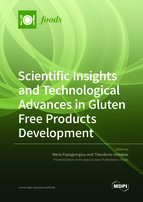Scientific Insights and Technological Advances in Gluten Free Products Development
A special issue of Foods (ISSN 2304-8158). This special issue belongs to the section "Grain".
Deadline for manuscript submissions: closed (10 October 2022) | Viewed by 62345
Special Issue Editors
Interests: tailoring functional and chemical properties of cereal and alternative plant sources in view of developing specific healthy foods and ingredients; grain safety; bioactive compounds; by products valorization
Special Issues, Collections and Topics in MDPI journals
Interests: food technology; food engineering; food safety; food quality; extra virgin olive oil; mycotoxins; fermented foods
Special Issues, Collections and Topics in MDPI journals
Special Issue Information
Dear Colleagues,
The prevalence of autoimmune disorders along with intolerance toward gluten and lifestyle trends have led to increased consumption of gluten-free products in the last two decades. The above has been accompanied with a steep rise in scientific publications on the topic of gluten-free, since both academia and the R&D sector of the food industry have been faced with the challenge to eliminate gluten and seek for substitutes. The prognosis for the global gluten-free products market is that it will continue to grow at a compound annual growth rate of 8.5% from 2020 to 2027.
Exploring alternative ingredients for the development of gluten-free products aiming to mimic the unique viscoelastic properties of gluten as a gas retention ingredient during fermentation, water binding and enabler of starch gelatinization on baking, and a bread flavor enhancer via gluten-related proteases is still a major field of research. Low specific volume, rapid staling, crumble and crumb structure, dry crumb, taste, and unbalanced nutritional profile are among the common defects in the final products associated with gluten absence.
This Special Issue addresses both new scientific insights and technological advances of gluten-free product development aiming to tackle the aforementioned issues.
Contributions pertinent to gluten-free cereals and pseudocereals, alternative protein sources, and other functional ingredients in view of their role in a gluten-free recipe, sourdough and the role of enzymes, as well as novel processes such as extrusion, microwave, fractionation on milling, germination, etc. that could have an impact on the quality of the final product both from the technological or nutritional point of view are particularly welcome.
Prof. Dr. Maria Papageorgiou
Prof. Dr. Theodoros Varzakas
Guest Editors
Manuscript Submission Information
Manuscripts should be submitted online at www.mdpi.com by registering and logging in to this website. Once you are registered, click here to go to the submission form. Manuscripts can be submitted until the deadline. All submissions that pass pre-check are peer-reviewed. Accepted papers will be published continuously in the journal (as soon as accepted) and will be listed together on the special issue website. Research articles, review articles as well as short communications are invited. For planned papers, a title and short abstract (about 100 words) can be sent to the Editorial Office for announcement on this website.
Submitted manuscripts should not have been published previously, nor be under consideration for publication elsewhere (except conference proceedings papers). All manuscripts are thoroughly refereed through a single-blind peer-review process. A guide for authors and other relevant information for submission of manuscripts is available on the Instructions for Authors page. Foods is an international peer-reviewed open access semimonthly journal published by MDPI.
Please visit the Instructions for Authors page before submitting a manuscript. The Article Processing Charge (APC) for publication in this open access journal is 2900 CHF (Swiss Francs). Submitted papers should be well formatted and use good English. Authors may use MDPI's English editing service prior to publication or during author revisions.
Keywords
• gluten free cereals and pseudocereals
• alternative protein sources
• sourdough and the role of enzymes
• novel processes in GF product development
• nutritional profile/fortification of gluten-free products
• sensory profile of gluten-free products
• gluten free reference material for gluten quantification
• gluten-free regulation issues
• consumer acceptability








